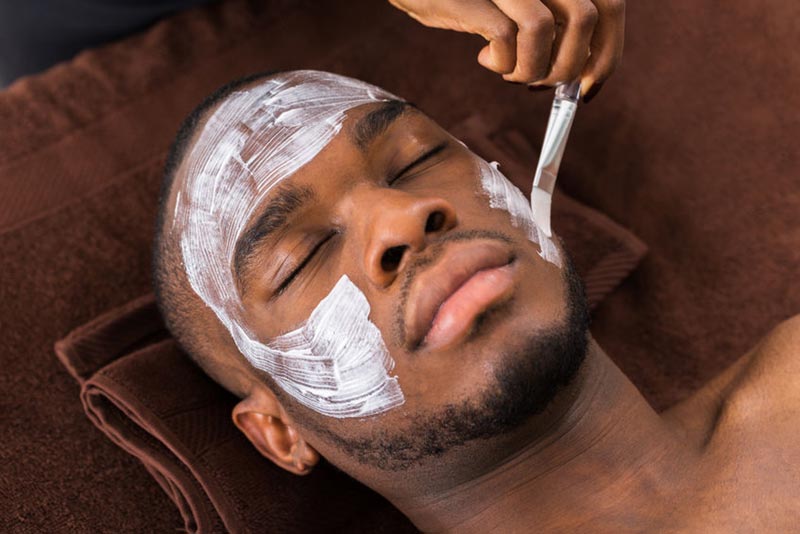
Until recently, going to the spa was largely considered a women’s pastime. But in the last decade or so there has been a big uptick in the number of male spa goers.
It’s not actually accurate to say going to spas is traditionally a female activity. The “spa” is named after the Belgian town of Spa, known for its healing waters. And the belief in the healing powers of bathing dates all the way back to prehistory. There is evidence that men have always enjoyed dipping themselves in the waters, from the ancient Celtic kings to the Classical Greeks and the Roman Soldiers. So, men are just returning to something they once enjoyed.
According to a recent ISPA report, 49% of U.S. spa-goers are men, up from 29% in 2005. This echoes a study by Lanserhof that reportedly found that 45% of their customers over five years were men.
What’s driving this change?
 We reached out to Garrett Mersberger, Director of Sales, Marketing and Spa at Blue Harbor Resort & Conference Center, and Chairman of the ISPA Board of Directors, to ask for some insight on what is driving this change and what spas should be doing to adapt.
We reached out to Garrett Mersberger, Director of Sales, Marketing and Spa at Blue Harbor Resort & Conference Center, and Chairman of the ISPA Board of Directors, to ask for some insight on what is driving this change and what spas should be doing to adapt.
For starters, Mersberger said, “People today, male and female, do not look at spas like they did 10 years ago. Spas are no longer viewed as places to go for pampering. Today, we are more educated on the health benefits – physical and mental – of going to spas and it is truly becoming a part of people’s monthly wellness regimen.
“Wellness is a global focus right now that speaks to both men and women among all generations. And visiting a spa is a huge part, and widely accepted form, of wellness.”
At Spa Executive, we would also guess that the shift is being driven in part by a western breakdown in the rigidity of traditional gender roles and norms, resulting in rising comfort levels with taking part in activities that were, until fairly recently, viewed by many as exclusively reserved for one gender or another.
Some interesting stats about male spa goers
So, what do we know about the male spa goer? Here are some findings from ISPA’s Consumer Snapshot Volume IX, released in spring 2019:
- Men are most likely to visit a spa alone (51%) or with a partner (38%).
- Men are most likely to book massage services, fitness or sports services, and skincare services.
- Men spend less on spa services than women, with a majority spending less than $80.
- More men, however, are more likely to go to a spa with the intent of purchasing retail products ‘some’ or ‘all’ of the time than women – 48% vs 37%.
- Men are also more likely to actually make that retail purchase than women (68% vs 61%).
- Most men have no preference as to the gender of their service provider (51%), while 36% prefer a female service provider and only 14% prefer a male service provider.
- More men than women like the idea of a technology ban in spas and would be encouraged to visit because of one – 32% vs 24%.
These findings may mean that spas should be looking at making significant changes to appeal to what is now a full half of their customer base.
Mersberger said, “This is a very exciting time for Spas and the entire industry. More men visiting spas means more demand for spa services and spa retail. But this also means that spas need to adapt to the change in demand.”
These are some of the key areas in which spa operators might want to consider making changes.
Expanded offerings
The ISPA report points out that, historically fitness offerings have been considered separate from “spa,” but the popularity of fitness services among men represents a big opportunity for the industry to target a new group of potential spa-users.
There may be more opportunities to expand offerings beyond this.
Redesigned spaces
Mersberger points also to the size of locker rooms. Traditionally, women’s locker rooms have been much larger than men’s. “The male locker room is often one quarter the size of the female locker room,” he said. That’s probably going to have to change.
“At Blue Harbor Resort & Spa, we are looking at what we can do to adjust our facility and menu to attract more men. For example, our locker rooms are co-ed facilities with private showers and changing cubicles for each guest. This allows us to meet the demand of our customers whether male or female.”
ISPA President Lynne McNees also told the Associated Press recently that “spas are really having to evolve to accommodate that male spa-goer. Typically, your back of house for males would be smaller because historically it’s been very heavy female. Now they’re having to shift that.”
Rethinking treatment menus and retail
Operators should also be taking a critical look at their treatment menus, Mersberger said.
“Oftentimes 90% of the menu is designed for the female clientele and they might have one page dedicated to male treatments. The growth in men visiting spas is definitely going to impact the way spas approach this. I think spas will start to eliminate the male specific menu pages. I know that sounds crazy, but what I mean is that spas will design their menu so that all services are approachable by both males and females.”
On top of the most popular treatments mentioned above, Mersberger points out that the recent ISPA study shows that men are also having manicures, pedicures, wraps, and facials. “So why create a male specific page where those are left off?” He asks. “Instead, design your menu and the descriptions of your services to speak to the spa goer…not male or female.”
As for retail, seeing that men are more likely to make a purchase than women, it would be wise to make sure that the products they want are available to them. Mersberger said, “We are also looking at our retail boutique, which right now is heavily skewed toward our female customers.
“It is important that we find the right products and services that appeal to our male guests. ”
A new approach to marketing
At the moment, most spa marketing is heavily geared towards women. Your new male guests should feel represented in your marketing, as this will make them feel welcome and comfortable.
Mersberger said, “I predict we will start to see more men in spa photography and videos online. I think you will also see spa online advertising start to pop up on more male focused web sites.”
Getting with the times
It’s just a matter of adapting to the modern era. And those who fail to do this might get left behind.
At least, said Mersberger, “Those spas that start to adapt to this change sooner rather than later will benefit the most.”
Spa Executive magazine is published by Book4Time, the world’s most innovative spa, salon, wellness, and activity management software. Learn more at Book4Time.com.



